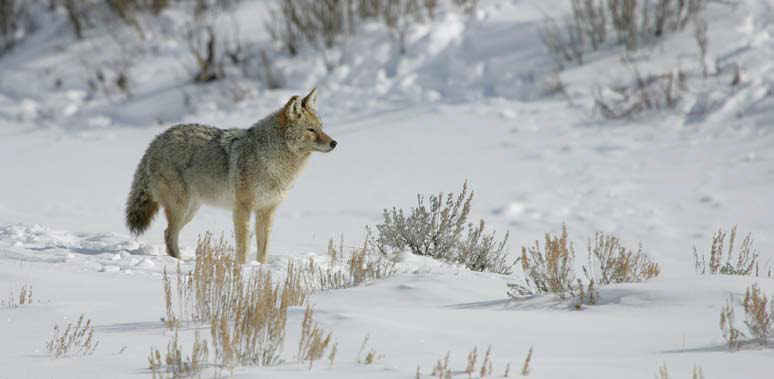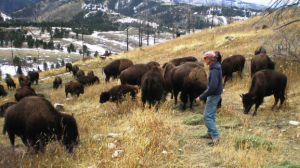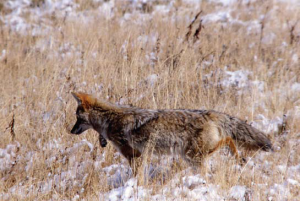Image by Jim Peaco, YNP.
An advanced system of communication, complex social structure and keen intelligence. The ability to live in nearly any environment on earth. Sound familiar? No, not homo sapiens. Canis lantrans – the American coyote – also fits this description. Historically found on the Great Plains, the American coyote has expanded its range over the last century largely in response to the niche left by wolves and human modifications of landscapes.
Though often eclipsed in the media by wolves, their larger relatives, coyotes play an important ecological role in their environments by maintaining healthy ecosystems and species diversity. As a top carnivore, coyotes help regulate the number and density of smaller carnivores, such as skunks, raccoons and foxes.
In Montana, coyotes can be found in diverse habitats and landscapes across the state. It is this adaptable, opportunistic nature that often creates conflict with people. On ranches and farms,
coyotes are viewed primarily as threats to livestock. Cattle and other grazers trample and consume vegetation that a coyote’s prey rely on – so coyotes look to sheep and other domestic animals as a food source. Currently, coyotes are the most abundant livestock predators in the country. “We mostly worry at calving season,” says Eve DeMarco, owner of Happy Hollow Farm in Marion, Montana. Happy Hollow prides itself on certification as “predator friendly,” using humane practices to keep livestock safe and wildlife alive.
Photo: Bison Quest Adventures on the Wild Echo Bison Ranch, www.bisonquest.com
Some, admittedly few, stockgrowers, even embrace the presence of Wile E Coyote. “We enjoy seeing coyotes immensely and love having them on our ranch. Of course, raising a native ungulate that can take care of itself, like our bison, is an easy way to co-exist with the rest of our native wildlife,” says Pam Knowles of Bison Quest Adventure Vacations in Townsend.
Coyotes tend to become more active, vocal and territorial during their pupping season, when food requirements are at a high. Females have one litter per year, typically in April, and the parents bring food to the pups until they are old enough to join them hunting. During this time, negative encounters between humans and coyotes can increase and intensify. Since ranchers often dispose of dead livestock and afterbirth in forests and fields, “this attracts coyotes and gives them a taste for domestic animals,” DeMarco says. Although most coyotes naturally fear humans, coyotes that associate humans with food can become unhealthily habituated to their presence. “Domestic livestock are at times easy prey when the owner is not around to protect the young and the older animals,” she continues. “We bring our cattle in near the house during calving to keep an eye on them. We have a bear dog, and llamas to alert us if the coyotes come in.”
Ranchers like DeMarco may benefit from work that the Blackfoot Challenge, a group that focuses on land use and conservation issues in the Blackfoot valley, is doing with grizzly bear and wolves. “We remove approximately 235 livestock carcasses each year from what once were “boneyards,” or pits where livestock carcasses were deposited during the calving season,” says researcher Seth Wilson. “This may help reduce the likelihood of having coyotes spend time near calving areas, since “attractants” like dead calves or mother cows have been removed to a carcass composting facility,” he explains.
However, Brian Giddings, of Montana Fish, Wildlife & Parks states that coyotes mostly are little threat to grown animals, “although they could take down any age sheep.”
“In some cases a pair of coyotes will keep their distance from farms and ranches – these are considered “good” coyotes that should be left alone because, being territorial, they will keep out other or new coyotes that could cause problems.”
Coyotes do provide a highly beneficial and popular service to farms and ranches, according to Giddings – the ability to “eat a lot of unwanted rodents.”
“Coyotes are efficient predators of small mammals such as mice and voles,” he says. “I have often seen coyotes mousing in a field adjacent to livestock. When the weather turns very cold it’s not that difficult to find coyotes out in the daytime, catching mice.”
Image by J. Schmidt, YNP
That coyotes “control” rodent populations is a common misperception, however. “Rodents have high reproductive rates in general, and coyotes often just harvest the surplus, taking what’s easiest
to catch. There’s very little evidence in the scientific literature that predators such as coyotes, foxes or bobcats can actually have a significant impact on a rodent population,” says Robert Timm, wildlife specialist at the University of California.
Hunting proclivities aside, unexpected moments spent observing this charismatic omnivore yield intriguing insight into their behavior. “Once I was playing ball with my border collie out in the field,” rancher Eve DeMarco recalls. “The coyote was very interested. He eventually sat down at a good vantage point and just watched the show. After a while he got up and headed away, I am sure to tell his pack what he had seen. “Most people just assume coyotes are aggressive killers,” she muses. “I just think they need to hire a really good PR agent.”
With at least 19 subspecies roaming throughout North America, coyotes are a vital part of both wilderness and urban environments. “That coyotes have withstood and even thrived under intense persecution over the last century is a testament to their adaptability, resilience and intelligence,” says Camilla Fox, founding director of Project Coyote, a national non-profit organization. “We must learn to coexist if for no other reason than that the coyote has proven time and time again she will persist”.
Originally reported by Lili DeBarbieri in the Montana Naturalist.



